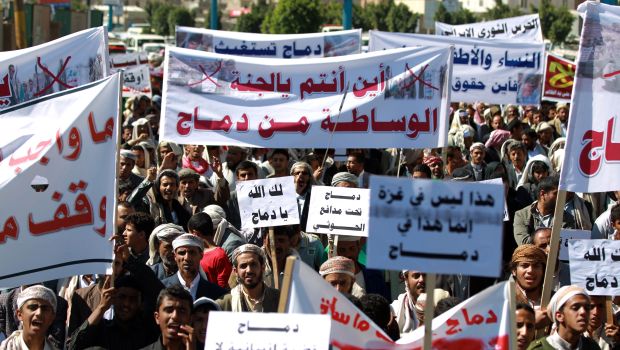
Yemenis shout slogans during a protest outside the home of Yemeni President Yemeni President Hadi against the fighting between the Shi’ite Houthi movement and Salafist militants in the northern town of Dammaj, on November 2, 2013 (AFP PHOTO/ MOHAMMED HUWAIS)
Sources in the town of Dammaj told Asharq Al-Awsat that 75 Salafists had been killed in attacks by Houthis on the Salafist stronghold in the last few days. The casualties included women and children, and many homes were destroyed, they claimed.
The Houthis did not declare any casualties on their side, denying reports of the death of the brother of their leader, Abdel-Malik Al-Houthi, in the battles in Dammaj.
The violence in the town, 25 miles (40 kilometers) from the border with Saudi Arabia, began on October 30, and has continued despite government attempts to broker a ceasefire.
Meanwhile, Asharq Al-Awsat has learned that dozens of Salafist fighters had travelled to Sa’adah governorate from various areas of Yemen to take part in the fighting.
Yahia Mansour Abu Osba’a, chairman of the Presidential Committee for the Dammaj crisis, told Asharq Al-Awsat on Saturday that an agreement had been reached to implement a ceasefire and that the agreement had come into effect.
The Yemeni Ministry of Defense website published a statement that said: “The ceasefire has been implemented by both parties of the conflict in the Sa’adah governorate,” and that “armed forces units have been deployed in areas where both parties were previously based.”
A source within the Yemeni military, speaking on the condition of anonymity, confirmed the ceasefire, and denied reports that Yemeni units in Sa’adah took part in the fighting in Dammaj.
The source said “the claims were false and they were deliberate propaganda aimed at smearing the reputation of the armed forces.”
However, on Sunday a local official told Reuters news agency that violence had continued, with three confirmed dead.
In another development, United Nations Secretary-General Ban Ki-moon made a telephone call to Yemeni President Abd Rabbo Mansour Hadi to discuss political conciliation in Yemen and the efforts made to make a success of the National Dialogue, which is almost finished.
Hadi expressed his appreciation for “the UN and the international community’s support to help Yemen out of its crisis.” Meanwhile, the UN secretary-general’s Special Advisor for Yemen, Jamal Benomar, has continued efforts to find a solution to the boycott of the National Dialogue Conference by the Southern Mobility Movement and their demands for the transfer of the venue of discussions of the Southern issue to outside Yemen, or any area outside the capital, Sana’a.
